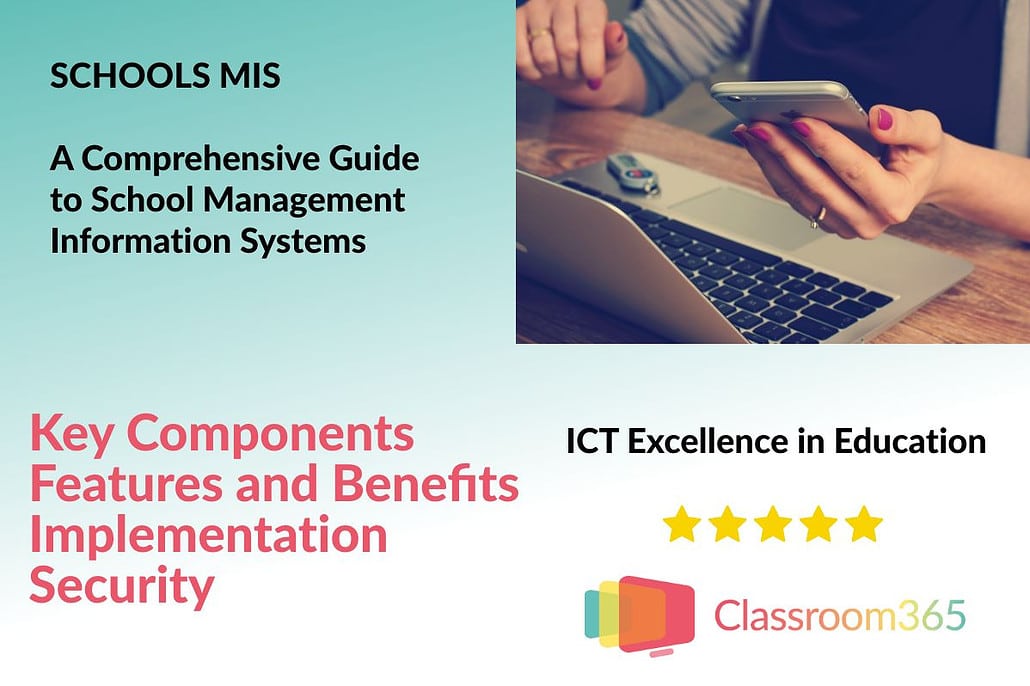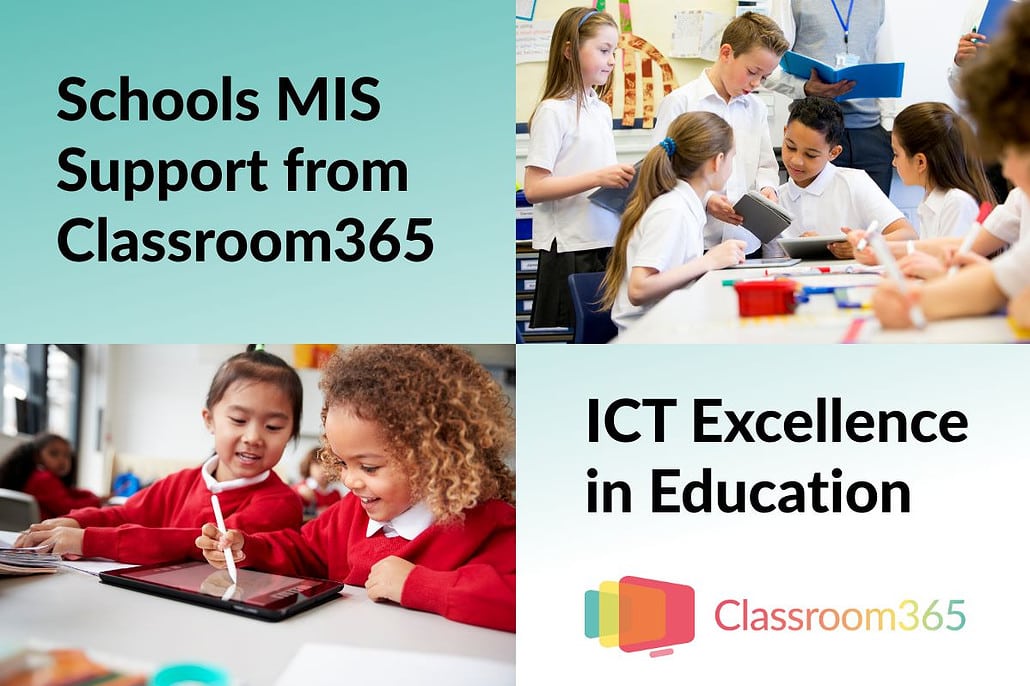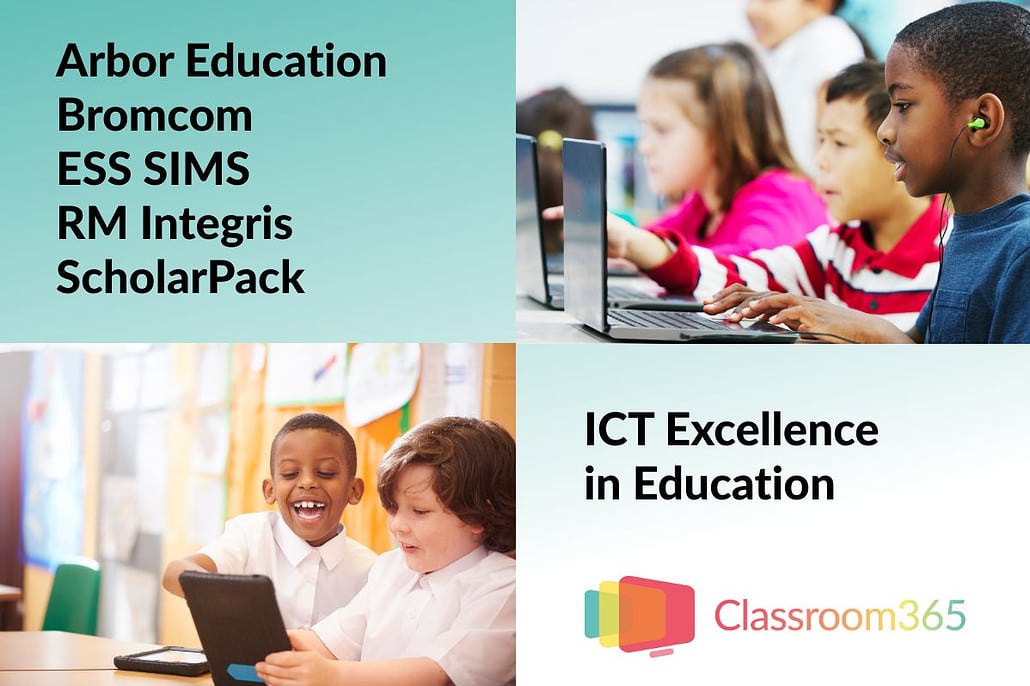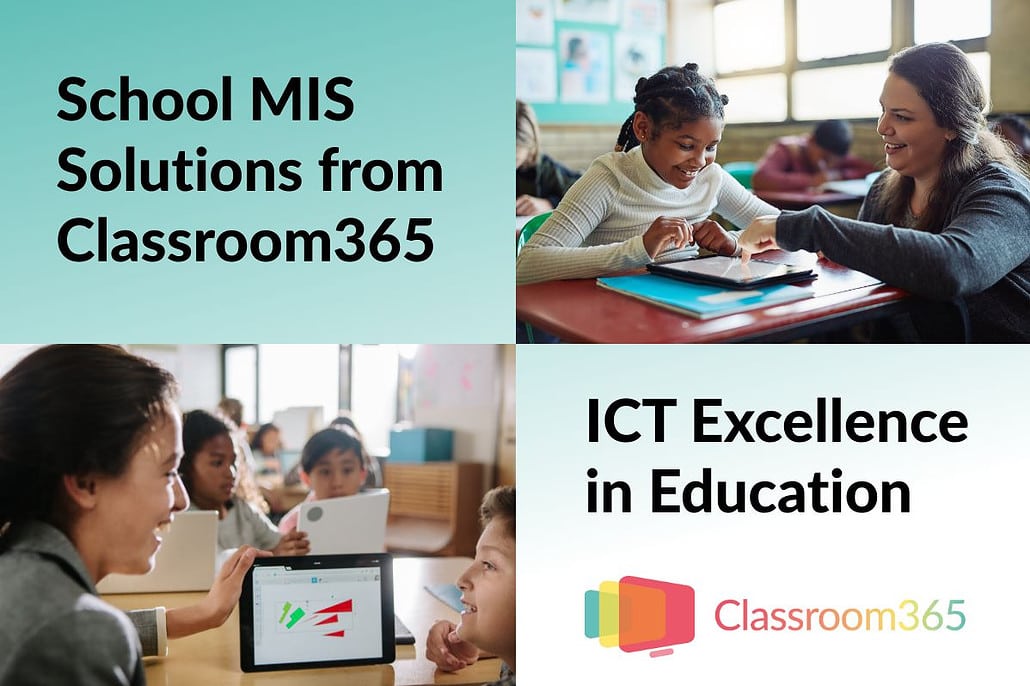School MIS – Management Information System for Schools
All schools must manage a wide range of tasks and responsibilities. From maintaining student records to communicating with parents, efficient school operation is essential.
A school management information system is a powerful tool that can help streamline these processes.
Classroom365 provides technical MIS support for the following MIS providers:
- Arbor Education
- ESS SIMS (formerly Capita SIMS)
- Bromcom MIS
- Integris MIS (formerly RM Integris G2)
- ScholarPack
Please complete the contact form below for impartial advice on what MIS would be best for your school, our recommendations and our school MIS support services. Read on to learn more about what a school MIS does and is for.
Understanding the Role of MIS in Schools: A Comprehensive Guide
Importance of efficient school management
Whether a primary or secondary school, management software is vital for delivering a high-quality education experience. By streamlining administrative tasks and syncing effectively with the school’s chosen learning platform, whether Google for Education, Windows, Apple or a hybrid approach, a school can focus on what matters most: teaching and learning. Furthermore, efficient governance helps to maintain a positive relationship with parents and the wider community.
Understanding the role of an MIS in schools
A school MIS is a centralised system that consolidates data, streamlines processes and automates routine tasks. With a school information management system, a school can manage their day-to-day operations more effectively, saving time and resources.
Effective MIS Support Services
A secondary or primary school MIS needs outstanding support both onsite and offsite. Luckily, Classroom365 provides these MIS services for schools, including Bromcom and Arbor support for cloud MIS solutions. In-school MIS servers, such as SIMS, require onsite ESS SIMS support.
School MIS - Ask Us for Impartial Advice
Introduction to MIS Systems for Schools
What is a School MIS?
A school MIS is a digital platform designed to manage, analyse, and report on the daily operations of an educational institution. It encompasses many functionalities, from student enrolment to timetable scheduling.
The Evolution of School Management System Software
The first management information systems were introduced in the 1960s as basic record-keeping tools. Over time, they have evolved into sophisticated platforms that integrate various educational technologies and support advanced data analysis.
Key Components of School MIS Software
Attendance Management
A crucial feature is enabling a school to monitor student attendance, track absences, and identify trends. This school data can help address issues such as chronic absenteeism and improve student outcomes.
Grading and Assessment
Streamline the grading and assessment data process by automating the calculation and recording of grades. Additionally, it can provide valuable insights into student performance, helping educators identify areas for improvement.
Timetable and Scheduling
They can simplify the process of creating and updating timetables, reducing the workload for school staff. They can also help manage resources more effectively, such as classroom allocation and teacher schedules.
Communication and Collaboration
Using an MIS can facilitate communication between staff, students, and parents, promoting a more collaborative learning environment. Features such as messaging, announcements, and document sharing can help keep everyone informed and engaged.
Student Information
Managing student information is central to a Management Information System. By consolidating all student and assessment data in one place, a school community can easily access and update records, ensuring accuracy and effective GDPR and compliance for school data protection.
What Are the Advantages of MIS in Schools?
Streamlined Administration
Significantly reduce the time spent on administrative tasks, allowing staff to focus on teaching and supporting students. Automation and centralised data management help to improve efficiency and reduce errors.
Enhanced Communication
Improve communication between staff, students, and parents by providing a platform for sharing information and updates. This increased transparency can lead to better engagement and collaboration.
Centralised Data Management
All student and staff data is stored in one secure, easily accessible location. This enables data administrators to access information quickly and ensure accuracy and compliance with data protection regulations.
Better Resource Allocation
Help schools allocate resources more effectively by providing insights into areas such as attendance, assessment, academic performance, and resource usage. This data driven approach can lead to more informed decision making and improved outcomes.
Choosing the Right MIS System for Your School
Assessing Your School’s Needs
Identify your school’s unique needs and priorities to ensure you select a school MIS that aligns with your goals and requirements.
Comparing the Different Products Available
Compare various solutions on the market, paying close attention to the modules available, functionality, ease of use, and integration capabilities. Seek feedback from other schools using this software to gain insights into their effectiveness.
Evaluating Costs and Benefits
Consider both the upfront investment and ongoing costs. Ensure the solution offers a good return on investment, taking into account potential savings in time, resources, and improved outcomes.
Support and maintenance
Choose an MIS software provider that offers comprehensive support and maintenance services. For Bromcom support, you can consider us at Classroom365. As a cloud MIS, the MIS system can be supported remotely. However, you still require a fast and stable network infrastructure to reliably access the Bromcom school MIS portal.
School MIS - More Info?
Implementing an Educational Management Information System
Planning and preparation
A successful implementation begins with careful planning and preparation. Develop a project plan, assign roles and responsibilities, and establish a timeline for implementation.
School Staff training and onboarding
Invest in staff training to ensure everyone is comfortable using the new MIS. This will help maximise the advantages of the software and encourage user adoption.
Monitoring and evaluation
Regularly monitor the performance of your software to ensure it continues to meet your school’s needs. Evaluate its effectiveness and make adjustments as necessary to improve outcomes.
Setting Performance Metrics: Establish clear performance metrics to help measure the success of your software. These might include improvements in efficiency, student outcomes, or parent engagement.
Regular System Review and Updates: Conduct regular system reviews to ensure the platform remains up-to-date and relevant. Stay informed about new modules, updates, and industry best practices.
Continuous Professional Development: Encourage ongoing professional development for staff to help them make the most of your MIS system. This may include attending workshops, webinars, or seeking additional training resources.
Types of Information Management Systems for Schools
Cloud based MIS
Cloud MIS software is hosted on remote servers and accessed via the Internet. This type of software offers several advantages, such as lower upfront costs, more effortless scalability, and automatic updates. It also enables users to access the software from anywhere, provided they have an internet connection. Bromcom MIS support can be done remotely as the entire system and its integrations run via the internet.
On-premise MIS
Onsite MIS solutions, for example, ESS SIMS, are installed and run on local servers within the school premises. This system typically requires higher upfront costs but offers greater control over data security and system customisation. Schools with their onsite or remote support are responsible for managing updates, maintenance, and backups.
Installation services from Classroom365, such as server and network upgrades and audits, will help prepare for an onsite ESS SIMS (formerly Capita SIMS) upgrade.
Hybrid Option
A hybrid approach combines elements of a school cloud MIS and an onsite setup. This is achieved by having an onsite installation with remote access to that system. These systems are becoming rare as most MIS software companies have migrated to the cloud. In Classroom365’s opinion, they can be ignored as they will only be viable for commercial operations with intricate existing setups. If you have this, then perhaps it’s time to change!
Essential Features of an MIS for Schools
When selecting a new software solution, along with the key components described above, look for the following:
- A user-friendly and intuitive interface.
- Secure MIS storage and backups. How long can you roll back your MIS installation if your data becomes corrupted or deleted? Look for 30 days minimum.
- Integration with other software tools. Compare with the different providers, as each has individual integrations.
- Customisable reporting.
- Scalability to accommodate growth as your school grows or you are considering joining a MAT.
- Staff and parent app with push notifications. Not all have this ability.
- Comprehensive support and maintenance with email, phone and even web chat, which Arbor MIS support includes.
- Supported by local authorities. Check first, especially if you choose one of the smaller providers.
Securing Your School Management System
Data Privacy and Compliance
Ensure your MIS complies with UK GDPR and school data protection policy regulations, including securing personal data and having policies to manage data breaches.
Cyber Security Best Practices
Implement cyber security best practices to protect from potential threats. This includes regular software updates, strong password policies, and employee training on cyber threats.
Regular Audits and Monitoring
Conduct regular audits and monitoring tasks to identify potential vulnerabilities and maintain network security. This proactive approach can help prevent data breaches and safeguard your school’s reputation.
Overcoming Resistance to Change
Resistance to change can be challenging when implementing a new school information management system. To address this, engage stakeholders in the decision-making, communicate the benefits, and provide comprehensive training and support.
The Impact on Pupil Premium Management and Reporting in UK Schools
The impact of an MIS on Pupil Premium management and reporting in schools is significant, streamlining processes and enhancing transparency.
With an effective solution, a school community can efficiently track and monitor the allocation of premium funds, ensuring resources are directed towards eligible pupils to close the attainment gap. Moreover, MIS software provides valuable insights into the progress of pupil outcomes, enabling data-driven interventions and targeted support. Additionally, automated reporting simplifies sharing data with stakeholders, including Ofsted, parents, and governors, fostering accountability and facilitating informed decision-making.
By utilising your software for Pupil Premiums, a school can better support disadvantaged pupils and optimise the impact of these crucial funds.
Supporting Special Education Needs with School Management Software
MIS tools and strategies are instrumental in supporting Special Education Needs (SEN) students, enabling teachers to manage learning plans and allocate resources efficiently. By utilising the capabilities, educators can gain a thorough understanding of each student’s specific needs, strengths, and challenges, ultimately facilitating the creation of customised learning experiences.
School MIS systems assist in tracking progress and outcomes, guaranteeing prompt interventions and precise support for SEN students. This data driven method empowers schools to continuously refine their strategies and make informed decisions about SEN provision. School MIS software also promotes seamless communication and collaboration among teachers, support staff, and parents, resulting in a more cohesive approach to addressing SEN students’ needs.
Moreover, integrating with assistive technologies and educational resources simplifies access to essential materials, fostering a more inclusive and engaging learning environment. Analytics and evidence based reporting allows schools to assess the efficacy of their SEN support services, pinpoint areas for improvement, and identify best practices.
By capitalising on all the tools and strategies available, a school can create a comprehensive and adaptive approach to supporting SEN pupils, cultivating an inclusive environment and enabling every student to realise their full potential.
Request More Information?
The Future of School Management Information Software
As technology continues to advance, it will become even more powerful and integrated with other educational software. Expect to see advancements in areas such as artificial intelligence, real time data analytics, and personalised learning. Keep an eye on emerging technologies and trends to ensure your school life remains at the forefront of innovation.
Adopting new technologies and embracing change is crucial for schools to stay relevant and competitive. Be open to new ideas and approaches, and encourage a culture of continuous improvement and innovation.
Management Information System for Schools – In Summary
School MIS software can significantly improve the efficiency and effectiveness of your institution’s operations. By understanding the key features, benefits, and implementation process, you can choose the right software for your school and reap the rewards of a streamlined and data-driven approach to education administration.
Learn more about the ICT services for schools and Multi-Academy Trusts from Classroom365.
Frequently Asked Questions (FAQs)
What does MIS mean in schools?
MIS means Management Information System. In a school environment, it is a platform that consolidates all student and staff data into one easy-to-use, usually cloud-based software interface.
How can schools ensure data security and privacy?
Schools can ensure data security and privacy by selecting a system that complies with relevant data protection regulations, implementing cybersecurity best practices, and regularly auditing and monitoring the system for vulnerabilities.
What is the typical cost of implementing an MIS System?
The cost of implementing a School MIS System can vary widely based on the specific solution and the school’s size and requirements. However, considering the potential benefits, such as improved efficiency, enhanced communication, and better data management, the investment is often justified.
Can a School MIS System be customised to fit the specific needs of my institution?
Yes, many school MIS solutions can be customised to fit the unique needs of your institution. This may include adding specific features or integrating with other software used by your school.
How can we get parents more involved?
To get parents more involved, ensure that one system includes features that enable parent access and effective communication, such as a parent portal, messaging solutions, or event calendar. Regularly update parents on school news and events, and encourage their participation in school activities.
How does School MIS Software integrate with other educational technologies and tools?
A school information management solution offers integration with other innovative educational software solutions, such as VLE solutions, online resources, and primary and secondary assessments. This helps to create a seamless and cohesive digital ecosystem for your school life.
What challenges do schools face when implementing and maintaining an MIS?
Common challenges include resistance to change, school staff training, and ensuring ongoing support and maintenance. To address these challenges, involve stakeholders in the decision making process, provide comprehensive training, and establish a strong relationship with the software supplier for ongoing onsite and remote support.
Mark Friend, BSc (Hons), is a Company Director at Classroom365 and has worked in technology for nearly 30 years. His IT career started with Rothschild Bank in Sydney, Australia, before working as a Global VPN Project Manager for the British Council. Mark has 20 years of experience in the UK education sector, helping schools integrate the latest tech into their curriculum and ICT vision.








